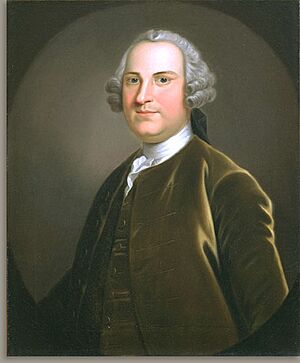James Willing facts for kids
Quick facts for kids
James Willing
|
|
|---|---|
| Born | 1750 |
| Died | 1801 (aged 50–51) |
| Occupation | Merchant |
| Known for | Willing Expedition |
| Parent(s) | Charles Willing Anne Shippen Willing |
| Relatives | Thomas Willing (brother) |
James Willing (1750–1801) was an American merchant and a representative for the Continental Congress. He led a military trip in 1778 during the American Revolutionary War. This trip, known as the Willing Expedition, involved raiding British forts and properties. These raids targeted loyalists in the British West Florida settlement of Natchez. Willing later sought safety in New Orleans but was captured by the British while trying to return to Philadelphia.
James Willing's Early Life

James Willing grew up in a well-known family in Philadelphia. His father, Charles Willing, served as the mayor of Philadelphia two times. His mother, Anne Shippen, was the granddaughter of Edward Shippen, who was also a mayor of Philadelphia. James's older brother, Thomas Willing, was a merchant and a representative for Pennsylvania in the Continental Congress. He also became the first president of the First Bank of the United States.
When he was younger, James Willing worked as a merchant. He ran a general store in Natchez, which was then a British colony in West Florida. During the American Revolution, most people in Natchez stayed loyal to the British king. Willing's business was not very successful. He eventually moved back to Philadelphia. There, he became a naval captain in the Continental Navy.
The Willing Expedition
In 1777, James Willing traveled to Natchez as a representative of the Continental Congress. His goal was to convince the people there to join the American fight for independence. The residents welcomed him kindly, but they did not agree to his plan. The landowners felt they owed the king for their land and for allowing them to have a form of government. Willing reported back to the Continental Congress that "West Florida was a serious threat" to the American cause.
Oliver Pollock and Bernardo de Gálvez began to plan military raids. Gálvez was the Spanish Governor of Spanish Louisiana. They sent a lot of supplies, worth about $70,000, to Fort Pitt. Pollock received a letter from Robert Morris and William Smith. These men were part of the Committee of Secret Correspondence. The letter said that Willing would lead a trip against loyalist settlements along the river near New Orleans. Pollock and George Rogers Clark helped raise money to pay for this military trip.
On January 11, 1778, Willing and 29 men from the 13th Virginia Regiment left Fort Pitt. They sailed down the Ohio River on a gunboat named USS Rattletrap.
Raids and Retreat
Willing and his group arrived in Natchez on February 19, 1778. They started raiding British forts, farms, and other properties belonging to British loyalists. On February 21, Willing made the people of Natchez promise to be loyal to the United States of America. Willing and his group continued to take property and raid the area. This period is known as the Willing Expedition. They took property estimated to be worth $1.5 million. By May 24, their efforts were finished. Willing then went to New Orleans to find safety from the British.
A few months later, Oliver Pollock paid for Willing to sail back to Philadelphia. However, a British ship stopped Willing's ship off the coast of Delaware. He was taken prisoner and held in New York. It is not completely clear how long he was held. Some say it was "a year or so." Others believe the British traded him for a captured British officer on September 3, 1781. However, a note from 1782 on Willing's company's records suggests he might still have been a prisoner.
James Willing lived in Haverford Township, Pennsylvania, at the end of his life. He passed away there in 1801.

